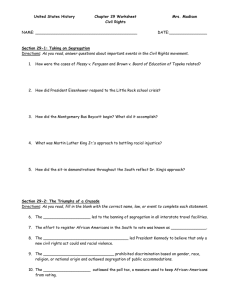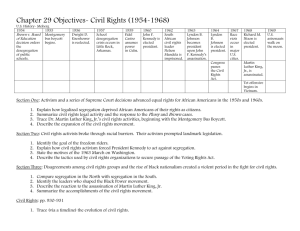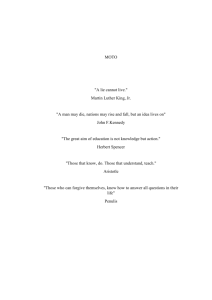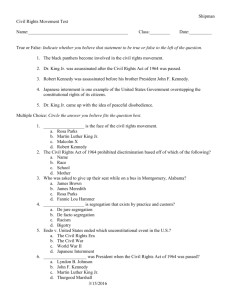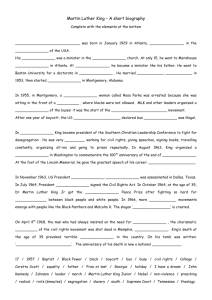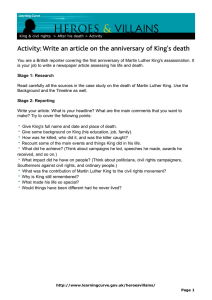Chapter Twenty-Eight The Civil Rights Movement, 1945–1966
advertisement
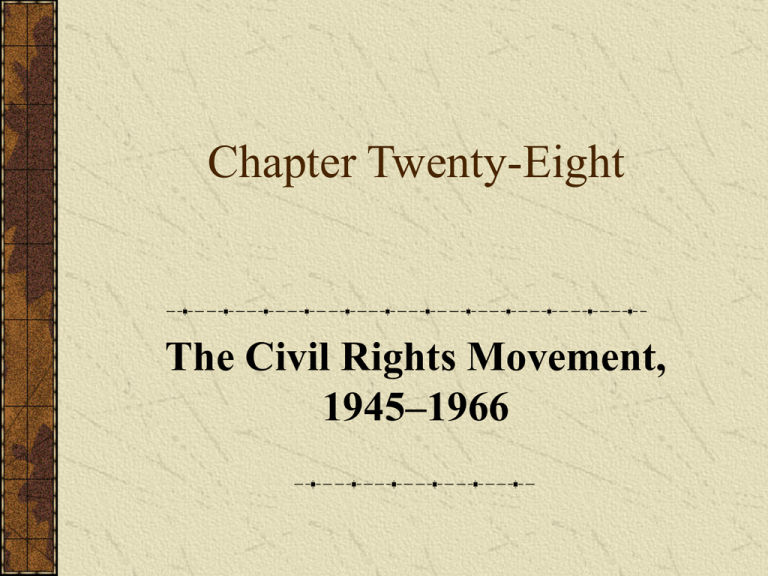
Chapter Twenty-Eight The Civil Rights Movement, 1945–1966 Part One: Introduction Chapter Focus Questions What were the legal and political origins of the AfricanAmerican civil rights struggle? What characterized Martin Luther King’s rise to leadership? How did student protesters take direct action in the South? How did civil rights affect national politics? What were the Civil Rights Act of 1964 and the Voting Rights Act of 1965? How did America’s other minorities pursue their civil rights? Part Two: The Montgomery Bus Boycott: An African-American Community Challenges Segregation Montgomery, Alabama In 1955, Montgomery’s black community mobilized when Rosa Parks refused to give up her bus seat and comply with segregation laws. Led by Martin Luther King, Jr., a Baptist minister, a boycott of buses was launched. A network of local activists organized carpools using private cars to get people to and from work. Leaders endured violence and legal harassment, but won a court ruling that the segregation ordinance was unconstitutional. Part Three: Origins of the Movement Civil Rights After World War II The WWII experiences of African Americans laid the foundations for the subsequent struggle. A mass migration to the North brought political power to African Americans working through the Democratic Party. The NAACP grew in numbers and its Legal Defense Fund initiated a series of lawsuits to win key rights. Key ways the African Americans were breaking color barriers included: Jackie Robinson’s entrance into major league baseball Ralph Bunche’s winning a Nobel Peace prize A new generation of jazz musicians created be-bop. The Segregated South In the South, segregation and unequal rights were still the law of the land. Law and custom kept blacks as second-class citizens with no effective political rights. African Americans had learned to survive and not challenge the situation. Brown v. Board of Education The NAACP initiated a series of court cases challenging the constitutionality of segregation. In Brown v. Board of Education, newly appointed Chief Justice Earl Warren led the court to declare that separate educational facilities are inherently unequal. The court postponed ordering a clear timetable to implement the decision. Southern whites declared their intention to nullify the decision. Crisis in Little Rock In Little Rock, Arkansas, a judge ordered integration. The governor ordered the National Guard to keep African-American children out of Central High. When the troops were withdrawn, a riot erupted, forcing President Eisenhower to send in more troops to integrate the school. Part Four: No Easy Road to Freedom, 1957–62 No Easy Road to Freedom Map: Map of the Civil Rights Movement Martin Luther King and the SCLC Martin Luther King, Jr. emerged from the bus boycott as a prominent national figure. A welleducated son of a Baptist minister, King taught his followers nonviolent resistance, modeled after the tactics of Mohandas Gandhi. The civil rights movement was deeply rooted in the traditions of the African-American church. King founded the Southern Christian Leadership Conference to promote nonviolent direct action to challenge segregation. Sit-Ins African-American college students, first in Greensboro, North Carolina, began sitting in at segregated lunch counters. Nonviolent sit-ins were: widely supported by the African-American community accompanied by community-wide boycotts of businesses that would not integrate. SNCC and the “Beloved Community” A new spirit of militancy was evident among young people. 120 African American activists created the Student Nonviolent Coordinating Committee (SNCC) to promote nonviolent direct challenges to segregation. The young activists were found at the forefront of nearly every major civil rights battle. The Election of 1960 and Civil Rights The race issue had moved to center-stage by 1960. As vice president, Nixon had strongly supported civil rights. But Kennedy pressured a judge to release Martin Luther King, Jr. from jail. African-American voters provided Kennedy’s margin of victory, though an unfriendly Congress ensured that little legislation would come out. Attorney General Robert Kennedy used the Justice Department to force compliance with desegregation orders. Freedom Rides The Congress of Racial Equality (CORE) sponsored a freedom ride of biracial teams to ride interstate buses in the South. The FBI and Justice Department knew of the plans but were absent when mobs firebombed a bus and severely beat the Freedom Riders. There was violence and no police protection at other stops. The Kennedy administration was forced to mediate a safe conduct for the riders, though 300 people were arrested. A Justice Department petition led to new rules that effectively ended segregated interstate buses. The Albany Movement: The Limits of Protest Where the federal government was not present, segregationists could triumph. In Albany, Georgia, local authorities kept white mobs from running wild and kept police brutality down to a minimum. Martin Luther King, Jr. was twice arrested, but Albany remained segregated. When the federal government intervened, as it did in the University of Mississippi, integration could take place. Part Five: The Movement at High Tide Birmingham In conjunction with the SCLC, local activists in Birmingham, Alabama, planned a large desegregation campaign. Demonstrators, including Martin Luther King, Jr., filled the city’s jails. King drafted his Letter From a Birmingham Jail. A TV audience saw water cannons and snarling dogs break up a children’s march. A settlement was negotiated that desegregated businesses. Birmingham changed the nature of the civil rights movement by bringing in black unemployed and working poor for the first time. JFK and the March on Washington The shifting public consensus led President Kennedy to appeal for civil rights legislation. A. Philip Randolph’s old idea of a march on Washington was revived. The march presented a unified call for change and held up the dream of universal freedom and brotherhood. LBJ and the Civil Rights Act of 1964 The assassination of John Kennedy threw a cloud over the movement as the new president, Lyndon Baines Johnson, had never been a good friend to civil rights. LBJ used his skills as a political insider to push through the Civil Rights Act of 1964 that put a virtual end to Jim Crow. Mississippi Freedom Summer In 1964, civil rights activists targeted Mississippi for a “freedom summer” that saw 900 volunteers come to open up this closed society. Two white activists and a local black activist were quickly killed. Tensions developed between white volunteers and black movement veterans. The project riveted national attention on Mississippi. With an overwhelming Democratic victory in the 1964 elections, movement leaders pushed for federal legislation to protect the right to vote. Malcolm X and Black Consciousness Many younger civil rights activists were drawn to the vision of Malcolm X, who: ridiculed integrationist goals urged black audiences to take pride in their African heritage break free from white domination He broke with the Nation of Islam, made a pilgrimage to Mecca, and returned to America with changed views. He sought common ground with the civil rights movement, but was murdered in 1965. Even in death, he continued to point to a new black consciousness. Selma In Selma, Alabama, whites had kept blacks off the voting lists and brutally responded to protests. A planned march to Montgomery ended when police beat marchers. Just when it appeared the Selma campaign would fade, a white gang attacked a group of Northern whites who had come to help out, one of whom died. President Johnson addressed the nation and thoroughly identified himself with the civil rights cause, declaring “we shall overcome.” The march went forward. The Voting Rights Act of 1965 In August 1965, LBJ signed the Voting Rights Act that authorized federal supervision of voter registration in the South. Map: Impact of the Voting Rights Act, 1965 Part Six: Civil Rights Beyond Black and White Mexican Americans & Mexican Immigrants Mexican Americans formed groups to fight for their rights and used the courts to challenge discrimination. Legal and illegal Mexican migration increased dramatically during and after WWII. During the 1950s, efforts to round up undocumented immigrants led to a denial of basic civil rights and a distrust of Anglos. Puerto Ricans Although Puerto Rican communities had been forming since the 1920s, the great migration came after WWII. Despite being citizens, Puerto Ricans faced both economic and cultural discrimination. In the 1960s and 1970s, the decline in manufacturing jobs and urban decay severely hit them. Indian Peoples During the 1950s, Congress passed a series of termination bills that ended tribal rights in return for cash payments and division of tribal assets. Indian activists challenged government policies leading to court decisions that reasserted the principle of tribal sovereignty. Reservation Indians remained trapped in poverty. Indians who had left the reservation lost much of their tribal identities. Urban Indian groups arose and focused on civil instead of tribal rights. Asian Americans During the 1950s, Congress removed the old ban against Japanese immigration and naturalization. In 1965, a new immigration law increased opportunities for Asians to immigrate to the United States. As a result, the demographics of the AsianAmerican population drastically changed. Part Seven: Conclusion The Civil Rights Movement, 1945–1966 Media: Chronology
